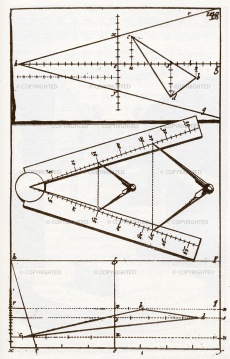Perspective Compasses
From Inventions
Name documented for the first time by Milles Denorry in 1588 (in French, compas optique).
Contents |
Inventor
Jacques Aleaume
Historic Period
ca. 1628
Description
Instrument for drawing in perspective. This name was used already in 1588 by Milles Denorry to indicate a surveying compass with optical sights. In the next century, however, other French mathematicians adopted the name of "compas optique ou de perspective" to indicate a proportional compass of the Galilean type with proportional scales for drawing in perspective. The necessary explanation of this instrument's operation was provided by Jean Louis de Vaulezard in the Abregé ou raccourcy de la Perspective… par l'ayde d'un Compas de Perspective faict pour cet effect in 1631. The compass had a line divided into equal parts and a ligne optique ou de la section (optical or section line) divided into 5000 decreasing parts. The division of this second line referred to a precise viewing point and served to draw a "primitive perspective view" whose points were transferred proportionally to a second perspective drawing relevant to another viewing point. A similar compass with five different "perspective lines" was described later by Johann Heinrich Lambert. In the work entitled Perspective adressée aux theoriciens [Perspective addressed to theoreticians] Girard Desargues describes the method for constructing a perspective drawing with the proportional compass but using only the arithmetic scale, that is, a line divided into equal parts: "Vous pouvez construire l'eschelle perspective, avec les lignes et le nombres ensemble; et avec les nombres seuls; et de plus vous la pouvez construire (qui est à dire que vous pouvez travailler en perspective, universellement à toute situation de l'oeil et du tableau plat) avec le compas de proportion, au moyen de la ligne de parties égales" ["You can construct a perspective scale with lines and numbers together; or with numbers alone; and moreover you can construct (that is to say, you can work in perspective, universally, with any positions of the eye and the flat picture) with the proportional compass, using the line divided into equal parts"] The operation of the compass was based on the "rule of three". To determine the perspective position of a point in the picture, two operations are carried out, to find the distance of the intersection point first from the horizon and then from the central axis (fig. 4c). In the first operation, the three known terms are the height of the viewing point, its distance from the painting and its distance from the point to be represented. Having applied the latter distance to the scale on the compass and established a space between the lines equal to the height of the eye, the interval between the intersection and the horizon is measured in correspondence to the distance from the painting applied to the compass's scale. In the second operation, the height of the eye is replaced by the distance of the point from the central axis, and the procedure is exactly the same.
Bibliographical Resources
Aleaume, Jacques. Introduction a la perspective, ensemble a l'usage de compas optique et perspective (1628), in Migon, Etienne, La perspective speculative et pratique... De l’ivention du feu Sieur Aleaume, Ingenieur du Roy. Mise au jour par Estienne Migon, Professeur és Mathematiques, Parigi, 1643.
Burja, Abel. Der mathematische Maler oder gründlische Anweisung zur Perspektive nach verschiedenen Methoden; nebst einem Anhange über die theatralische Perspektive und der Beschreibung eines neuen perspektivischen Instruments, Berlino, 1795, cap. V.
Denorry, Milles. L’Usage du compas optique…, G. Linocier, Paris, 1588.
Desargues, Girard. Perspective addressée aux théoriciens, in Poudra, Noël Germinal, Ouvres de Desargues, 2 voll., Parigi, 1864, pp. 460-462.
Inventario dei beni di Federico Cesi, Roma, Bibl. Lincea e Corsiniana, Archivio Linceo 32, cc. 84v-102v ("Compasso optico grande scudi tre").
Lambert, Johann Heinrich. Kurtzgefasste regeln zu perspectivischen Zeichnungen, Augsburg, 1768.
Nicolò, Anna; Solinas, Francesco. Per una analisi del collezionismo Linceo: L’Archivio Linceo 32 e il Museo di Federico Cesi, in Federico Cesi, Atti del Convegno (Acquasparta, 7-9 ottobre 1985) Roma, Accademia Nazionale dei Lincei, 1986, pp. 193-212, in part. pp. 206-212.
Vaulezard, Jean Louis de. Abregé ou raccourcy de la Perspective par l'imitation. Dans lequel est traicté, du moyen de changer une Perspective en une autre semblable, ayant la distance et hauteur de l'oeil comme aussi les distances ou enfoncement des objects plus grands ou moindres que leur semblable en la premiere. Ensemble l'invention d'approprier duex ou plusieurs Perspectives, ou parties d'icelle es une mesme, et sous une mesme distance d'oeil. Le tout par l'ayde d'un Compas de Perspective faict pour cet effect; avec l'usage d'iceluy pour faire le Perspectives des quelques object proposé, que se soit. De plus des Preceptes infallibles pour metre en Perspective, pourtraire et peindre toutes les choses, par l'imitation des naturelles. Oeuvre utile et necessaire à tous Peintres, Architectes, Graveurs et autres qui se servent du dessein. Par le Sieur DE VAULEZARD Mathematicien, Parigi, 1631.
Images
Author of the entry: Filippo Camerota

